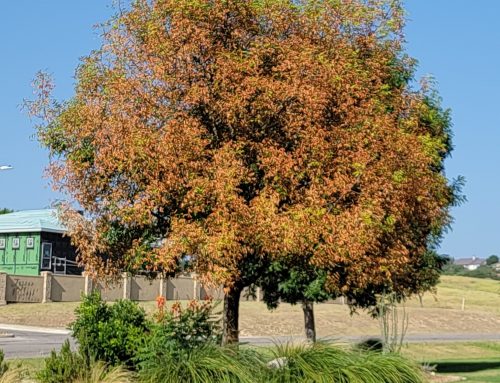Leaf Scorch is not a disease but rather a widespread noninfectious occurrence caused by adverse environmental conditions following prolonged periods of hot, dry, windy and bright sunny weather. Leaf Scorch is often referred to as a disease but does not result from a fungi, bacteria, or virus. However, this does not rule out their presence but may coincide with Leaf Scorch. Testing for fungal, bacterial or viral infection should be done to confirm a pathogen has infected the tree or if it is Leaf Scorch by process of elimination. Texas (or Buckley’s) Red oak, Texas Southern (or Spanish) Red oak, and Shumard Red oak are highly likely to develop Leaf Scorch. Black Jack, Post and Live oaks may also be affected. The problem may appear on almost any tree if the weather conditions become particularly unfavorable – prolonged drought, high temperatures, dry wind and low soil moisture. Leaf Scorch may also appear when long periods of wet, cloudy weather are followed abruptly by dry, windy and hot sunny weather.

Leaf Scorch usually develops as an irregular yellowing, faded green, brown or bronzing of the tissue between the veins or along the margins and tips of the leaves.

This is not true for all trees as patterns may differ in other species. These same symptoms are often misdiagnosed as symptoms of Oak wilt or Phytophthora, which are very similar in appearance. When water is lost quicker during transpiration than can be replaced, the resulting condition appears as Leaf Scorch. The normal seasonal rate of water movement to the top of some trees can be rapid and in Red oaks it moves at a rate of 92 ft/hr as compared to about 4 ft/hr in Live oaks. As the condition progresses, leaves, branches or entire limbs may dry up, turn brown and become brittle. Leaves sometimes wilt rapidly, and when this happens, they remain a pale green in color even though they are dried out. Damage is usually more pronounced on the upper, windward or southern side of trees. Trees may lose many leaves prematurely during the summer and exhibit branch or limb dieback.

When Leaf Scorch is discovered, the tissue has usually dried past the point of recovery, but steps can be taken to prevent more damage and may improve conditions in the future. Thorough, deep watering will usually help increase water uptake (keeping that in mind, when conditions persist, it is time to water to prevent the Leaf Scorch before it starts). Early spring applications of micro nutrients and mycorrhizae will aid the in the tree’s efficiency in water uptake. Establish a good disease and insect program against the loss of vigor in the trees transportation system. Air spading can loosen soil compaction which can inhibit water absorption. Remove any rock and/or weed fabric as these products only hamper soil conditions. Instead, use a light layer of mulch to help keep soil moist, about 2-3 inches deep and if watering is needed, be sure to water in deeply as mulch will absorb surface water.


